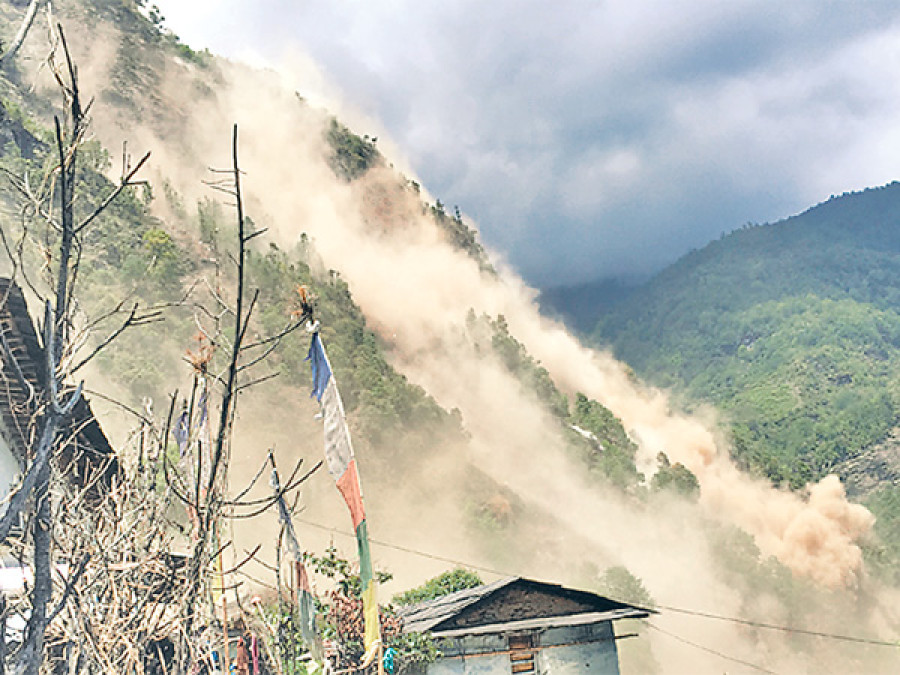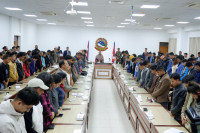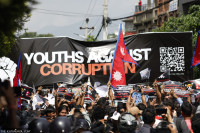Opinion
Slipping and sliding
The earthquakes will leave a lasting impact on the Nepali landscape, especially its slopes and watersheds
Madhukar Upadhya
Assessment of the total damage caused by the April 25 earthquake and the subsequent tremors will take years, and some of the damage perhaps will never be known. But what is becoming clearer is that the tremors that have violently shaken Nepal will leave a lasting impact on the landscape to a considerable depth.
Mountain slopes throughout the earthquake-affected area, covering more than 29 districts, have been destabilised—14 of them severely. Thousands of landslides in those districts have already changed the face of the slopes. Vehicular movement along the highways has been obstructed. Settlements and farms have numerous cracks on the ground. One doesn’t need to be an expert to tell that these cracks will develop further when the monsoon sets in, and result in widespread landslides and gullies in the earthquake-affected area.
Some of them could be as big as the one we had in Jure of Sindhupalchok in 2014. Regular water channels in the watersheds have also been damaged, altered, or destroyed completely. It is uncertain how such changes will affect local hydrology and subsequently, the land and local water sources in the area.
Staying home
The extent of the damage has been so deep and wide that it will take several years for us to begin to realise the extent of the damage caused by the earthquake to livelihood bases in the mountains. Since dry landslides and cracks have been seen in most places, the priority for now is to relocate people from the areas where the land has been seriously damaged, or are likely to get damaged beyond repair by the monsoon rain. But that would not solve the problem. First, not all of the people affected by the landslides can be relocated; neither is this feasible, because of the sheer number of people affected by the landslides.
Second, many of them may not like to leave their place of origin, despite the challenges they face, if opportunities are available in their places. They will do all they can with their limited capacity to rebuild their homes and livelihoods. We saw this in the 1993 flood disaster in several villages that were damaged seriously. Even now, people in the village of Barpak, the epicentre of the earthquake, where just about all of its 1,400 houses were destroyed by the earthquake, have already asserted themselves by rebuilding damaged houses and infrastructures, and continue to live there. There will be many other villages that will do the same, but those who cannot rebuild their homes and livelihoods will abandon the land and move to new places to start a new life, irrespective of support from the outside, as has always happened in the event of disasters.
Third, many of the destabilised areas may not be visible in the short term and people will continue to live in the same place, where seeds of many potential problems, such as slope stability or loss of aquifers, have already been planted by violent shaking. All of this will be visible only over a period of time.
Water availability
Landslides and gullies generally have ripple effects downstream, which will continue to impact areas far away from the earthquake-affected regions. For example, farmlands that are not damaged by the earthquake will be lost when landslides deposit debris on stable farmlands located at lower elevations in the valleys. Streams and rivers will carry a massive amount of sediment, which will get deposited along the rivers and streams and the fertile land further downstream. The sediment-laden river water will continually change the river geometry and pose threats to the bank areas, undermining the stability of river terraces. A knock-on effect will repeat in the following monsoons for some years.
One of the serious consequences of these physical damages to the land is changes in the availability of water. Some preliminary signs of change have already been seen. People in many places noticed a general increase in discharge in wells, springs, and streams immediately after the earthquake. In some places, the rise was unusually high. Springs that had dried decades ago have started to flow. The rise in the discharge could have been a result of the violent churning of the upper aquifers in the mountains and the opening up of new channels, which forced the aquifers to deplete rapidly after the shaking. With the squeezing of the aquifers in the mountains, most springs in the higher elevations are likely to shrink or disappear for good. In such cases, a large number of drinking water systems that collect water from sources in the upland will be seriously hampered. With shrinking of upper aquifers and the change in the landscape, we may witness an overall change in the regulatory function of the watersheds, which may cease to yield the same amount of water in the dry season as they did prior to the earthquake.
Livelihood concerns
The long-term implication of the earthquake to the livelihood bases would be seen in the loss of farmland and water sources within the watersheds. Therefore, restoration of both land and water sources are important in the long term. Though it is too early to say how things would unfold, a serious monitoring of the developing scenario of land and water sources at the local level as well as the subsequent change in the water regime, if any, within the watersheds, is required to understand the situation and develop a programme to restore land and water sources in the earthquake-affected areas.
It needs to be recalled that the most widespread water-induced disaster that Nepal ever faced was probably that of 1954. The first agriculture conference held in 1958 recognised how the event led to a loss of livelihood base in the mountains and recommended necessary measures to restore land and water sources. However, our capacity to restore them has remained weak. The erosion and landslide problems that we might see in the coming monsoons could be on a much larger scale covering a wider area than in 1954. Our capacity to restore land and water sources will be very important in rebuilding the livelihood base of millions of people. Let’s hope that a new chapter now begins in building our capacity to restore damaged land and water sources.
Upadhya is a hydrologist and the author of the book ‘Ponds and Landslides’




 12.12°C Kathmandu
12.12°C Kathmandu










